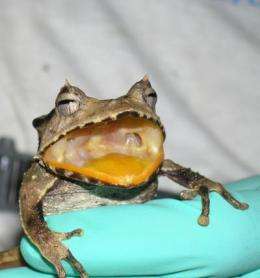DNA barcoding reveals 5 undiscovered frog species among 30 wiped out by fungal epidemic in Panama

The first before-and-after view of an amphibian die-off has just been published by scientists working at the Smithsonian Tropical Research Institute in Panama and the University of Maryland.
Like a wave, the fungal disease that wipes out frogs—chytridiomycosis—is advancing through the Central American highlands at a rate of about 30 kilometers per year. After the disappearance of Costa Rica's golden frogs in the 1980s, Karen Lips, associate professor of biology at the University of Maryland, quickly established a monitoring program at untouched sites in neighboring Panama.
Of the 63 species that she identified during surveys of Panama's Omar Torrijos National Park located in El Copé from 1998 to 2004, 25 species disappeared from the site in the subsequent epidemic. As of 2008, none of these species had reappeared there.
Were there additional species in the park not previously known to scientists? To find out, the authors used a genetic technique called DNA barcoding to quickly estimate that another 11 unnamed or "candidate" species were also present. In DNA barcoding, short genetic sequences that uniquely identify known species are generated and stored in public databases. By comparing DNA profiles from unknown organisms to the databases, researchers can identify biological specimens quickly, and construct genetic lineages. Combining the field data with the reconstructed genetic lineages, the authors discovered that five of these unnamed species were also wiped out.
"It's sadly ironic that we are discovering new species nearly as fast as we are losing them," said Andrew Crawford, former postdoctoral fellow at STRI and member of the Círculo Herpetológico de Panamá, now at the University of the Andes in Colombia. "Our DNA barcode data reveal new species even at this relatively well-studied site, yet the field sampling shows that many of these species new to science are already gone here."
An epidemic that wipes out a whole group of organisms is like the fire that burned the famous library of Alexandria. It destroys a huge amount of accumulated information about how life has coped with change in the past. Species surveys are like counting the number of different titles in the library, whereas a genetic survey is like counting the number of different words.
"When you lose the words, you lose the potential to make new books," said Lips, who directs the University of Maryland graduate program in Sustainable Development and Conservation Biology (CONS). "It's like the extinction of the dinosaurs. The areas where the disease has passed through are like graveyards; there's a void to be filled and we don't know what will happen as a result."
"This is the first time that we've used genetic barcodes—DNA sequences unique to each living organism—to characterize an entire amphibian community," said Eldredge Bermingham, STRI director and co-author. "STRI has also done barcoding on this scale for tropical trees on in our forest dynamics-monitoring plot in Panama. The before-and-after approach we took with the frogs tells us exactly what was lost to this deadly disease—33 percent of their evolutionary history."
More information: Andrew J. Crawford, Karen R. Lips and Eldredge Bermingham. 2010. Epidemic disease decimates amphibian abundance, species diversity and evolutionary history in the highlands of central Panama. Proc. Nat. Acad. Sci. online Early Edition, week of July 19.
Provided by University of Maryland



















